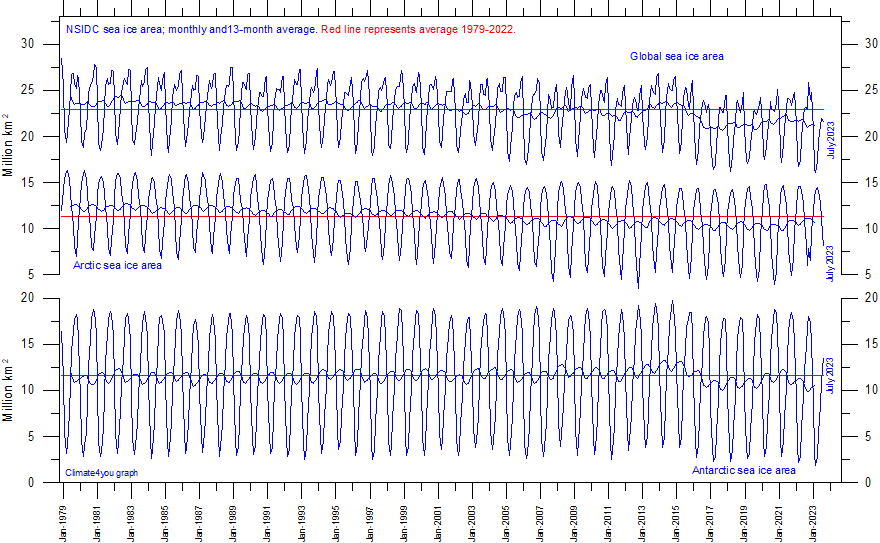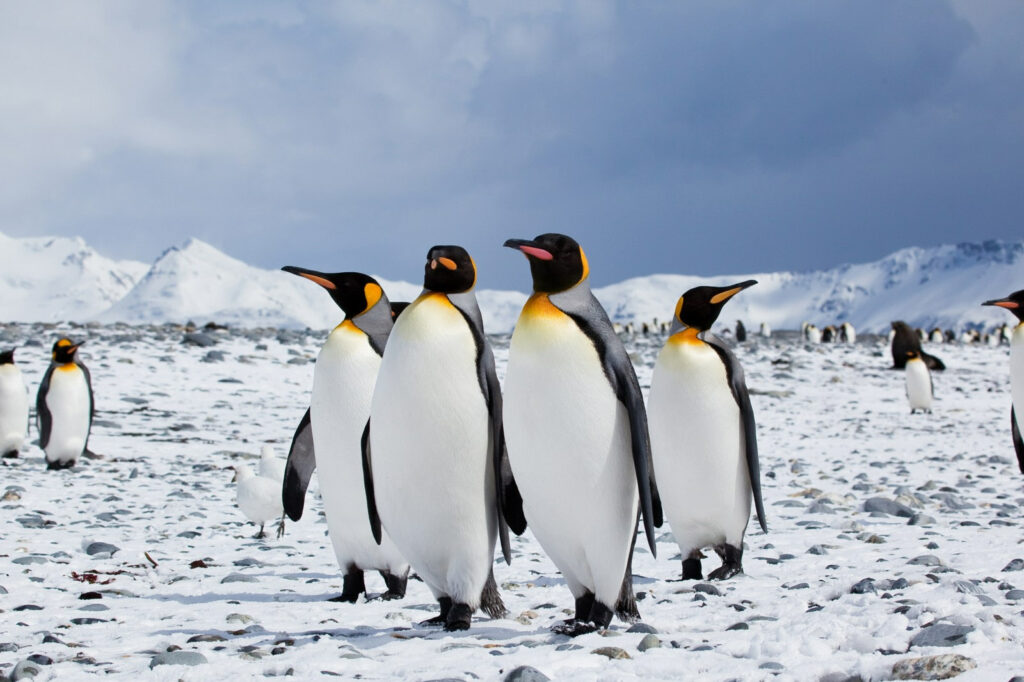That perennial alarmist favourite, the end of Antarctica as we know it, is back. As in “UK homes could be at risk of flooding if Antarctica becomes ‘global radiator’ and ice melts”, complete with irresistible images of those adorable penguins being brutally climate-changed. Nooooo!!! Not penguins!!! Scientific American sobs, literally in their email teaser, that “Penguin Chicks Are Dying Off as Antarctic Sea Ice Disappears/ Record-low sea ice caused Emperor Penguin chicks to die across Antarctica last year. This year could be just as bad”. Notice how it’s never a slug, always something cute? And if the polar bears won’t croak on cue, surely an Emperor or an Adelie will stage a heart-rending death scene amid the vanishing ice floes? One so protracted and implausible that no opera company would touch it, we might add.
As for that vanishing ice, we have to ask where it went. No, not the ice, which would have turned into water and drowned us all. The vanishing. As this chart from climate4you.com shows, with the usual natural fluctuations that modern environmentalists just can’t seem to get their heads around, the extent of both Arctic and Antarctic sea ice since 1988 has been amazingly… stable. And if the bottom of the cycle in summer was a record, it was only by a tiny amount.

The Economist also got into the game with its dispassionate, totally neutral “The Climate Issue” newsletter telling us:
“In the past few months we’ve published a lot of dramatic-looking charts about extreme weather and climate change. But perhaps one of the most alarming has focused on Antarctic sea ice.”
How “alarming”? Well, see, the ice was behaving totally normally including when it hit its lowest Southern Hemisphere summer nadir in the modern satellite era. But then:
“By July 6th Antarctic sea ice covered an area roughly the size of two Indias plus two Argentinas, when it really should have had an extra Argentina added on. By this point, climate scientists were surprised, to say the least. Since then the gap has narrowed slightly, but there is still far less ice than there should be.”
Cute. Although it might be useful to add that the area of India is 3.28 million square kilometers and of Argentina 2.78. And if we know what the sea ice area “should” be, and how much it “should” fluctuate, well, it’s down from a soothing 14.9 to an alarming 12.12. Or would be except it has gone up since.
They also offer a long and ponderous explanation of their scary charts that “brings grim scenarios into view” but doesn’t try to justify stretching the Y-axis and calibrating it in “standard deviations” for added spooky plungingness of lines. But once again it gives the game away while trying to sow panic, by saying:
“This abrupt decline looks even more extreme set against long-run patterns. Unlike the Arctic – where, in recent decades, the maximum sea-ice extent has been gradually shrinking, and the minimum has plummeted – the range of ice cover in the Antarctic has been relatively stable during the past half-century.”
So what you’re saying is that this famous climate breakdown has had no impact on Antarctic sea ice in half a century so we should all panic at a blip. Right. Climate science at its finest.
As for journalism at its finest, an Op Ed in the Guardian asks, with apparent ghoulish eagerness, “Is the climate crisis finally catching up with Antarctica?” Thus admitting that so far the evidence didn’t match the theory. And since it also said “Finding the answer has never been more pressing” we offer a plot spoiler: No it is not. Not “finally” and not at all. (Also, not to be snide, the author “is a physical oceanographer at the British Antarctic Survey” which is a fine thing to be, but when he says “the need for sustained research and investment in Southern Ocean and Antarctic science, along with its underpinning infrastructure and technology for our future has never been more pressing than now” he definitely has a dog in the funding debate. And they say we’re in it for the money… which you can send us here.)
As Chris Morrison wrote on The Daily Sceptic (h/t Anthony Watts), some of that famous context here would have included that “Antarctica sea ice was at a record high in 2014” as you can indeed see on the chart above. And that early and incomplete satellite data suggests it was this low in 1966. But in any case, how can a level marginally lower than that seen on many recent occasions have been so catastrophic? Is nature made of spun glass, and shatters if bumped?
No. But this climate campfire story is, including its blazing Antarctic heatwaves. (And of course records are no longer just broken when it comes to climate: “Even in Antarctica - one of the most remote and desolate places on Earth – temperature records are being shattered.” What next? Exploded? Obliterated?) And its typical assertion that the science is absolutely settled and the problem is far worse than scientists thought. Thus Scientific Alarmism has two scientists who say saying:
“that they expected to see Emperor Penguins suffer as sea ice disappeared but that ice loss – and its consequences to penguins – has accumulated faster than predicted.”
As so often with climate scares, the massive penguin die-off is all invented pseudo-data. As Jim Steele noted irritably, “there were no observed dead chicks ever counted”. Instead, a set of guesses about the ratio of non-breeders to breeders, the location of breeding sites and the meaning of excrement stains on the pristine Antarctic snow led “click-bait media” into a feeding frenzy. In which nobody remembered their high-school-biology lesson about boom-and-bust cycles to boot.
Even Scientific Communism eventually gets around to admitting, after quoting a British Antarctic Survey geographer that “That’s totally unprecedented. We’ve never seen that before” without admitting that they hadn’t “seen” it now either, that the same scientist says:
“If you went back maybe 15 years, Emperor Penguins were one of the least-known species in Antarctica. It’s almost impossible to get to most of their breeding colonies. We didn’t know how many there were or where they were.”
Still don’t, in fact. To quote Steele again, or rather a 2023 paper Remote sensing of emperor penguin abundance and breeding success (by a penguin researcher with the fortuitous name of “Winter”) via Steele:
“Of the 61 currently known emperor penguin breeding colonies, ground truth population counts conducted during the winter, at regular, frequent intervals, are only available for 2 colonies, at Pointe Géologie in Adélie Land and Atka Bay in Dronning Maud Land”
Nature also whimpers that “In the wake of record-low sea ice in Antarctica, scientists worldwide fear that crucial research will be disrupted because of looming budget cuts at the Australian Antarctic Division.” To which we retort irritably that you can make things up from a distance just as easily, before suggesting they apply for research grants to go and make up for it by counting actual Emperor Penguins instead of theoretical ones.
P.S. On the subject of smashing records, AP misinforms us that “European scientists make it official. July was the hottest month on record by far”. Ooooh. By far. How far? Well, see:
“Now that last month’s sizzling numbers are all in, the European climate monitoring organization made it official: July 2023 was Earth’s hottest month on record by a wide margin. July’s global average temperature of 16.95 degrees Celsius (62.51 degrees Fahrenheit) was a third of a degree Celsius (six tenths of a degree Fahrenheit) higher than the previous record set in 2019, Copernicus Climate Change Service announced Tuesday. Normally global temperature records are broken by hundredths or a tenth of a degree, so this margin is unusual.”
What’s actually unusual is a bunch even of journalists thinking anyone can measure the temperature of the entire planet to a hundredth of a degree, or that 0.3C can credibly be referred to as a “wide margin”. We defy any reader to turn their thermostat up or down by that amount and see if anyone else in the house notices.



They can’t measure the temperature of the planet, period, let alone to within a hundredth of a degree. They make SWAGS, or more accurately, they make WAGS.
They can't predict the weather two weeks from now with even vague certainty,much less what the temperature will be.Anywhere on earth.
I think the emperor has lost his clothes!